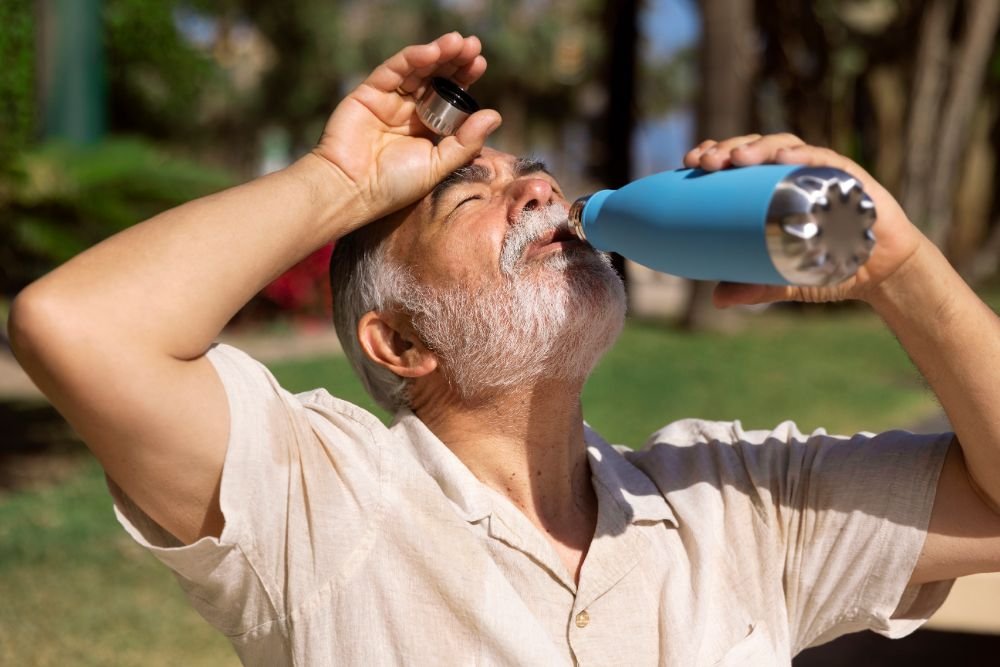As temperatures rise, so does the risk of heat stroke, a severe heat-related illness that can lead to critical health issues.
Knowing the heat stroke manifestations is essential for anyone exposed to high temperatures or engaging in strenuous activities.
Table of Contents
Understanding Heat Stroke
Heat stroke is the most severe form of heat injury and requires immediate medical attention. When the body’s temperature regulation fails, it can lead to a rapid rise in core body temperature, potentially causing significant damage to the brain, heart, kidneys, and muscles.
If not treated promptly, heat stroke can lead to severe complications or even death.
Boost Your Heart Health Today: Discover Essential Nutrients for a Stronger Cardiovascular System! – Learn more now!
Symptoms of Heat Stroke
High Body Temperature
One of the hallmark symptoms of heat stroke is a high body temperature. The body temperature typically rises above 104°F (40°C), and in severe cases, it can reach 106°F (41°C) or higher.
This excessive heat can cause various systemic effects, highlighting the urgency for immediate cooling and medical intervention.
Central Nervous System Abnormalities
Heat stroke can lead to several central nervous system abnormalities, including:
- Confusion and Agitation: A person may appear confused, agitated, or exhibit slurred speech.
- Delirium and Seizures: Severe cases may progress to delirium, seizures, or even coma.
- Altered Mental Status: Irritability and unusual behavior changes are common early indicators.
These symptoms are due to the impact of high temperatures on brain function, emphasizing the need for rapid cooling and medical care.
Nausea and Vomiting

Nausea and vomiting are frequent symptoms of heat stroke. The body’s attempt to cope with extreme heat can lead to gastrointestinal distress, making the person feel extremely unwell.
Flushed, Hot, and Dry Skin
During a heat stroke, the skin often becomes flushed, hot, and dry, with the absence of sweating. This is contrary to heat exhaustion, where sweating is typically profuse. The lack of sweating indicates the body’s failure to regulate its temperature effectively.
Rapid Heart Rate
A rapid and strong heart rate is a common symptom of heat stroke. The heart works harder to pump blood to the skin in an effort to dissipate heat, leading to an elevated pulse.
Headache
A severe headache is often one of the first symptoms of heat stroke. The intense heat causes blood vessels to dilate, leading to a pounding headache that can be debilitating.
Fatigue and Weakness

Individuals experiencing heat stroke often feel extreme fatigue and weakness. The body’s energy reserves are depleted as it struggles to cope with the excessive heat, leaving the person feeling exhausted and weak.
Transform Your Health Routine: Support Your Heart with this Essential Nutrients Today! – Click here for more info!
Signs of Heat Stroke
Hypotension
Heat stroke can lead to hypotension, where blood pressure may be normal or low. This occurs due to the dilation of blood vessels and the loss of fluids through sweating and evaporation.
Hyperventilation
Rapid, shallow breathing, or hyperventilation, is a sign of heat stroke. The body attempts to expel heat through increased respiratory rate, which can be observed in those suffering from this condition.
Elevated Liver Enzymes
Elevated liver enzymes are indicative of liver damage caused by heat stroke. The liver, like other organs, can suffer from the effects of high body temperature, leading to enzyme elevation detectable through blood tests.
Muscle Cramps or Weakness
Muscle cramps or weakness are common during heat stroke. The intense heat and dehydration can cause muscles to cramp and weaken, further complicating the person’s condition.
Rhabdomyolysis
Rhabdomyolysis, the breakdown of muscle fibers, can occur during heat stroke. This process releases myoglobin into the bloodstream, which can lead to kidney damage if not treated promptly.
Disseminated Intravascular Coagulation (DIC)
A serious complication of heat stroke is disseminated intravascular coagulation (DIC), which involves abnormal blood clotting. DIC can lead to both excessive clotting and bleeding, making it a critical condition requiring immediate attention.
Recognizing Early Symptoms
Recognizing early symptoms of heat stroke is crucial to preventing the condition from escalating. These initial symptoms can quickly progress to more severe manifestations if not addressed:
- Fatigue: A general feeling of tiredness or exhaustion.
- Dizziness: Lightheadedness or a sensation of spinning.
- Nausea and Vomiting: Feeling sick to the stomach, which may lead to vomiting.
- Headache: Often described as severe or throbbing.
- Altered Mental Status: Confusion, agitation, or irritability.
Identifying these symptoms early and taking immediate action, such as moving to a cooler environment and hydrating, can prevent the condition from worsening.
Prevention and Management
Preventing heat stroke involves taking proactive measures, especially during hot weather or physical exertion. Here are some key prevention tips:
Stay Hydrated
Maintaining adequate hydration is crucial in preventing heat stroke. Drink plenty of fluids, especially water, and avoid alcohol or caffeinated beverages that can dehydrate you.
Dress Appropriately
Wear lightweight, loose-fitting clothing and a hat to protect yourself from the sun. Light-colored clothes can help reflect sunlight, keeping you cooler.
Take Breaks
If you’re working or exercising in the heat, take frequent breaks in the shade or a cool environment. Allow your body to cool down periodically to prevent overheating.
Avoid Peak Heat Hours
Try to avoid outdoor activities during the hottest parts of the day, typically between 10 a.m. and 4 p.m. Schedule strenuous activities for cooler times of the day.
Use Cooling Techniques
Use fans, air conditioning, and cool showers to help lower your body temperature. Applying ice packs to the neck, armpits, and groin can also be effective.
Conclusion about Understanding Heat Stroke Manifestations
Understanding the manifestations of heat stroke is essential for early recognition and prompt treatment.
By being aware of the symptoms and signs, you can take immediate action to prevent severe complications.
Remember to stay hydrated, dress appropriately, take breaks, avoid peak heat hours, and use cooling techniques to protect yourself and others from the dangers of heat stroke.

